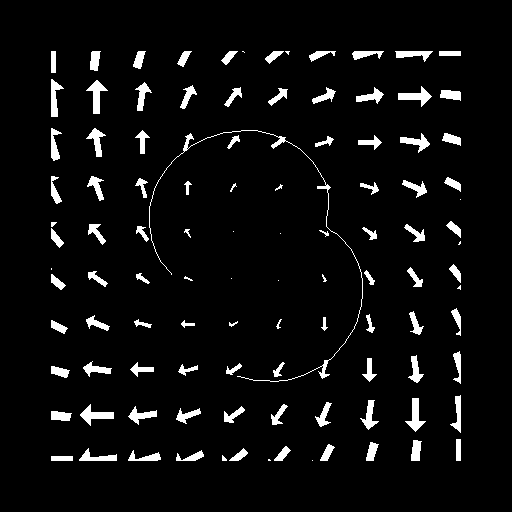The picture below shows an arbitrary, two dimensional vector field, ![]() . (We could do everything with a
more
general vector field in any number of dimensions, but then it's almost
impossible to draw.) The curve, C, is also shown. This is the path
of integration.
. (We could do everything with a
more
general vector field in any number of dimensions, but then it's almost
impossible to draw.) The curve, C, is also shown. This is the path
of integration.

To get a feel for what the line integral really is, imagine
that you are a bug standing at the point labelled A on the curve. As you
walk along the path, each step will bring you to a new point. At each of these
points, you will examine two things. The first is the vector field. Remember
that a vector field is a function that assigns a vector, ![]() , to each
point (x,y). So, each time you take a step, make note of the vector that
is associated with the vector field there. Then look at the vector associated
with the curve, the tangent vector,
, to each
point (x,y). So, each time you take a step, make note of the vector that
is associated with the vector field there. Then look at the vector associated
with the curve, the tangent vector, ![]() . To compute this point's
contribution to the line integral, we want to know how much of
. To compute this point's
contribution to the line integral, we want to know how much of ![]() is
in the direction of
is
in the direction of ![]() , so take the dot product,
, so take the dot product, ![]() .
.
Notice that the vector ![]() will, in general, change from point to
point on any path. Since
will, in general, change from point to
point on any path. Since ![]() changes also, this means we will have to
visit each point of the curve C and compute the dot product
changes also, this means we will have to
visit each point of the curve C and compute the dot product ![]() . Then we can total all of these dot products to get an estimate for
the line integral. Realize that this is only an estimate, since there are
an infinite number of points on C and we are only visiting a few of them.
. Then we can total all of these dot products to get an estimate for
the line integral. Realize that this is only an estimate, since there are
an infinite number of points on C and we are only visiting a few of them.
The animation below shows this process. For simplicity, we will only take eight steps to get from A to B. This will give us nine dot products to add up. At each of these nine points, we compute the amount of the vector field in the direction of the curve using the dot product.
(animation goes here.)
There are a few minor details of which to be careful. First of all, the
curve C
must be smooth with a starting point and an ending point. It should
never cross itself (like a figure eight). This will ensure that at each
point on the curve we will have a uniquely defined tangent vector to use in
computing the dot product. The next item of note is that, since the dot
product is positive if two vectors lie less than ninety degrees apart, then,
if the line integral is positive, the vector field points generally in the
same direction of the curve. If the line integral is zero, then one of two
things has happened. Either the vector field is perpendicular to the path
everywhere (so that each of the dot products is zero), or there were some
places where the curve went with the vector field and some places where it
went against the vector field and the total cancelled out. The last item to
be wary of is the existence of ![]() . Since
. Since ![]() is a function,
it may not be defined everywhere. To compute a line integral of
is a function,
it may not be defined everywhere. To compute a line integral of ![]() along a curve C, the vector-valued function
along a curve C, the vector-valued function ![]() must be defined
(ie. it must exist) at each point on C.
must be defined
(ie. it must exist) at each point on C.